
Original Link: https://www.anandtech.com/show/2683
Velocity Micro Edge Z55: Core i7-940 with CrossFire 4870
by Matt Campbell on December 12, 2008 2:00 AM EST- Posted in
- Systems
Introduction
We've looked at a number of systems here at AnandTech, and Velocity Micro has always been on our "to-do" list based on their popularity and prevalence in the market. The guys from Virginia sent one of their new Edge Z55 systems our way with a Core i7-940 to put through our review cycle. How does it hold up? As this is our first time looking at Velocity Micro, we'll look at the company themselves, and then try to answer that question. Worth note is that this is also our first Core i7 system review, so we may see some teething problems with the brand new technology.
Velocity Micro - Company Overview
Velocity Micro has seen tremendous growth in the past few years. Their introduction into Best Buy stores in 2005 was a huge step, as was their acquisition of Overdrive PC in 2007. Below is their summary from their webpage:
"Velocity Micro, Inc. is the premier high-performance personal computer provider in North America. Founded in 1992, Richmond, Va.-based Velocity Micro custom builds award winning gaming, mobile, multimedia, home office, small business, pro workstation, and visual supercomputer solutions. Velocity Micro consumer systems are available at Best Buy, MicroCenter, Circuit City, and select Staples retail stores nationwide, as well as online vendors Amazon.com, Newegg.com, TigerDirect.com, CompUSA.com, and many others."
On their "Why VM" webpage as well as their video, they further detail what they believe sets them apart, including in particular "care and craftsmanship". We will keep both of these claims in mind throughout the review.
Ordering Impressions
Velocity Micro's website comes up immediately from a web search. They've generally received positive press coverage, and they carry a 7.73 six month / 8.47 lifetime rating on ResellerRatings.com. As has been mentioned before, many factors must be taken into consideration besides the raw score, but often the customer feedback is useful to read through. Quite a few posts point to satisfaction with the build quality and customer support, and VM responded to several of the "Dissatisfied" posts. One item worth noting from that feedback is 24/7 tech support is only an available option when ordering through the website, not from retail stores such as Best Buy.
Velocity Micro's website is well designed, good looking, and breaks down the product categories clearly with a reasonable number of choices in each (7 gaming, 3 Digital Media, 5 Home Office, 3 Notebooks, and 5 Home Theater).
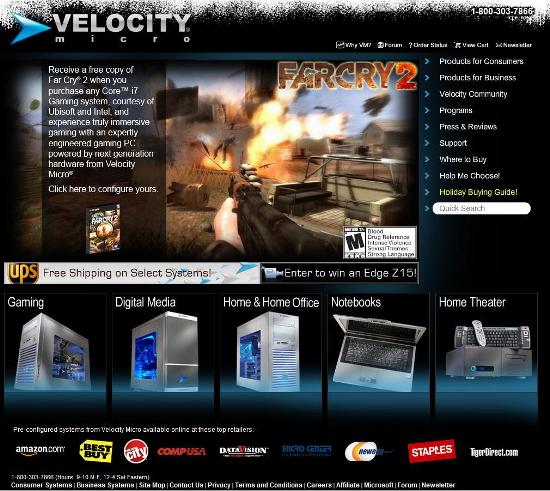
Their least expensive gaming machine starts at $799, though that base configuration is with an ATI HD 3450 that won't get you very far with any modern game except at very low resolutions/detail settings. The highest end configuration is the Raptor Signature Edition, starting at $5499. The system we're looking at is a Core i7 equipped Edge Z55, which costs around $3600 as configured (see the Specifications page for more information).
The ordering process is very straightforward; clicking "Configure Now" will load the base configuration with the preselected options, along with a "Your Performance" metric that follows you on the right hand side as the price updates with option changes. There are also links to launch a live chat session with a customer service representative and a "Finance Now" button that links to a VM credit card application.

Overall there are a reasonable number of options for each component, though some of the options are priced higher than we'd like to see (such as video cards), and unlike many custom gaming PC makers there were a lack of CPU cooling options. This is somewhat forgivable with the Core i7 as new coolers and adapter plates are being released, but their Edge Z15 Core 2 systems only offer one option other than the Intel stock heatsink, and even their top-of-the-line $5500 Raptor uses a stock Intel heatsink/fan. This definitely holds back their cooling ability and everything that follows from that (overclocking limits and potentially long-term stability). Speaking of overclocking, there's no mention of it during ordering - just that each system receives individual "performance tuning"; i.e., there is no way to pay for a guaranteed overclock covered by the warranty, unlike with other gaming companies. The question marks next to each component give popups that are generally not helpful; the Live Chat would be a much better resource to get questions answered.
At the time of writing, the Edge Z55 comes with a free gaming bundle of Far Cry 2, Ghost Recon, Lost Planet, and Supreme Commander. This is a good selection and definitely value added software for a gaming rig. A free T-shirt is also offered, but sorry, only in XL.
Their telephone support number was extremely easy to find at the bottom of every webpage (main number, extension 5), which we appreciate, and in addition there is a "Live Chat" feature available during business hours. Support hours are Mon-Fri. 9am - 10pm EST. Available for purchase at an additional cost, there is also a 24/7 number available for emergencies only (e.g. system will not boot) that allows one to reach an on-call technician. Calculating shipping unfortunately requires a login via email - this is a big pet peeve, as it's a hassle for potential customers. Likewise, shipping is a fixed charge not tied to location; the Edge Z5 came up at $79. This is clearly priced above actual cost, as we've seen cases twice as large ship cross country for less, but it may be easier for VM to charge a flat rate. Regardless, it'd be nice to pay actual shipping charges.
A brief list of Pros and Cons regarding the website layout and content is as follows:
Pros
- Website easy to find and
well laid out
- Good product segregation
- Easy ordering process
- Live Chat option
- Prominent support information
Cons
- CPU cooling options very
limited
- "Help me Choose" not helpful
- Shipping calculation requires login, rates fixed and somewhat high
Specifications
As we'll discuss in more detail later in this review, we actually ended up with two different review systems. The review configuration of the Edge Z55, as first received, had two 150GB Raptor drives in RAID 0, along with a 1.5TB storage array. The second PC used for the bulk of the benchmarks strictly had a 1TB storage drive, and that is the configuration we've used for the baseline below. With the Raptors, the configuration costs around $4000; as configured below, it's about $3600.
| Velocity Micro Edge Z55 System Specifications | |
| Processor | Intel Core i7 940, overclocked to 3.2 GHz |
| Motherboard | Intel DX58SO |
| Memory | 6 GB Corsair XMS3 DDR3-1600 |
| Video Card | Two (2) ATi Radeon HD 4870 512MB |
| Power Supply | 850-Watt Modular |
| Case | Velocity Micro GX2-W Aluminum |
| Hard Drive | One (1) 1.0 TB Hitachi SATA |
| OS | Vista Home Premium 64-bit, SP1 |
| Removables | Memory Card Reader |
| DVD Burner | Lite-On Blu-ray Reader Lite-On 20x DVDRW with Lightscribe |
| CPU Cooler | Stock Intel HSF |
Exterior and Interior
The system arrived in a brown box bearing the Velocity Micro title and information. It wasn't overly large and was extremely easy to carry thanks to the solid handles in each side.
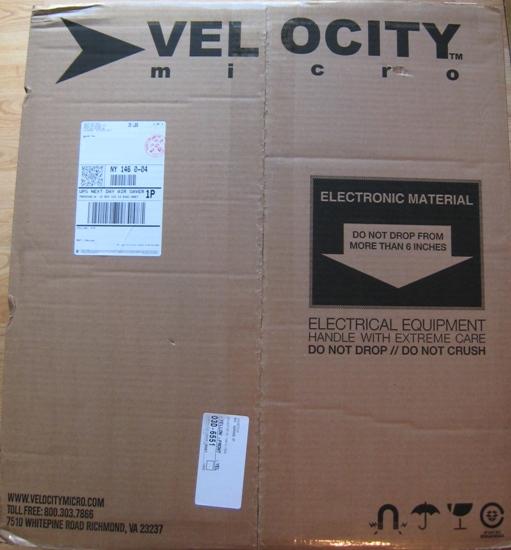


It may sound silly, but it's a bit of a letdown to many if they order a $3,000+ gaming rig and it arrives in a big, plain brown box - there's a nice mix of branding here.

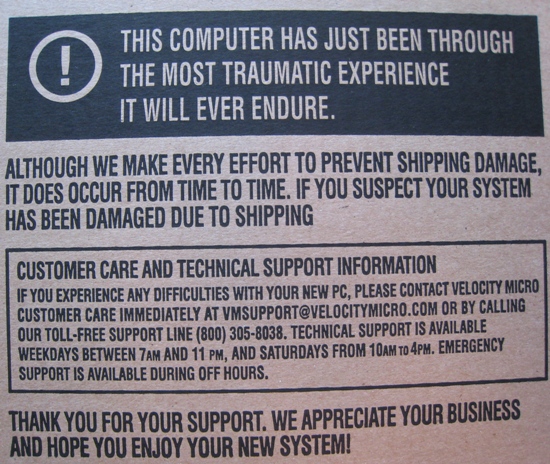
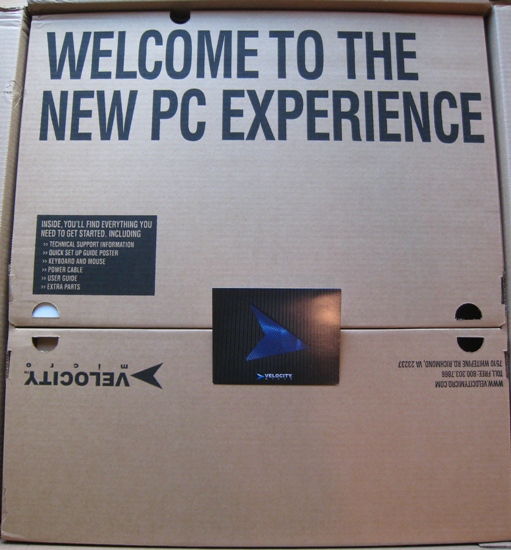
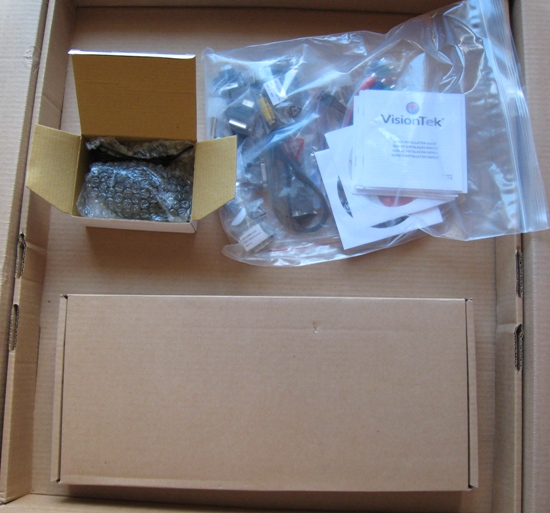
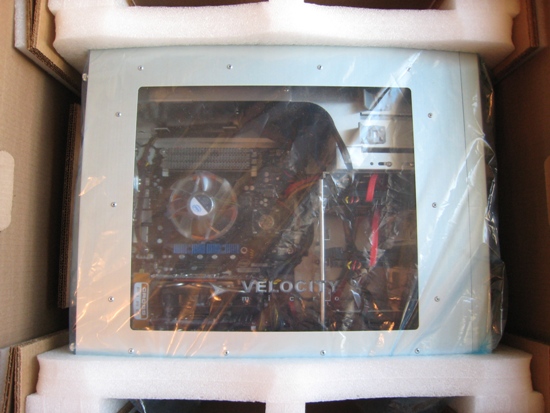
Overall, this is great packing job - the small "tray" containing the keyboard, mouse, and other accessories sits above the case and handles, giving a positive surface to push your fingers against while carrying. The Styrofoam inserts fit well and are easy to remove. We also like that the technical support information is listed directly on the box (though the hours have recently changed), and when the case is revealed it's undeniably good-looking.
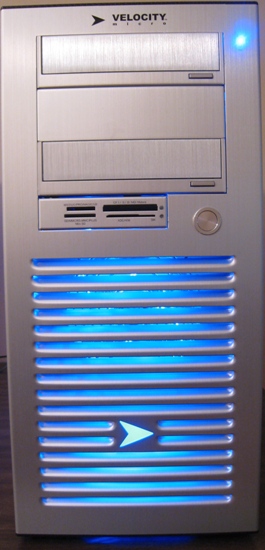
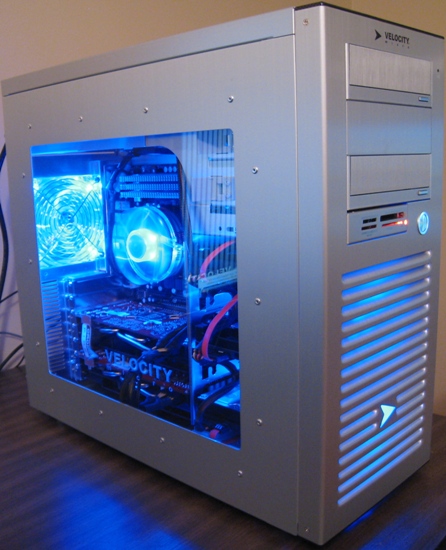

First system with RAID0
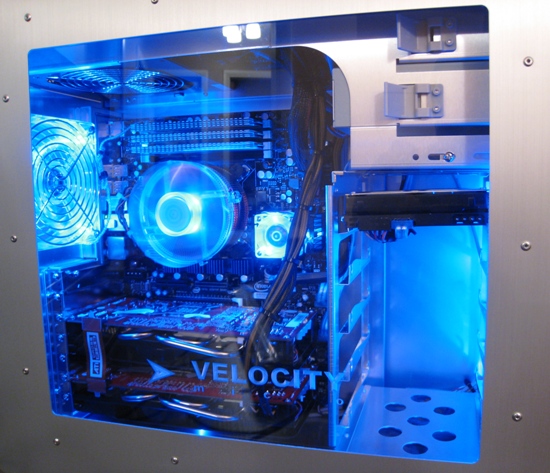
Second system without RAID
Though the box claims we are supposed to get a quick set up poster and a user guide, we got neither in our shipment. This may be attributed to the fact that VM had to rush to get us a Core i7 review system; however, these items as well as an owner's binder, preferably with benchmark results, are what we expect to see in a system at this price.
The case itself is nicely constructed and light, with a side window and some carbon fiber-esque accents on the top and bottom of the front face. The Velocity Micro logo is cut into the front panel with blue backlighting and looks quite nice when powered up, and the side window likewise has the name and logo cut into the plastic. It's a nice branding effect without being overpowering. Two thumbscrews on the side panel allow tool-free access, and overall, the system is well constructed and has very neat wire routing.
Setup and Startup
We've mentioned before that many systems we get in after being shipped need reseating or adjustment prior to startup. Some of this is attention to packing and some of it is luck. In this case, the system fired right up out of the box.
First let's take a look at the BIOS. This is a stock Intel board, but it does contain some overclocking features.

BIOS Config. 1
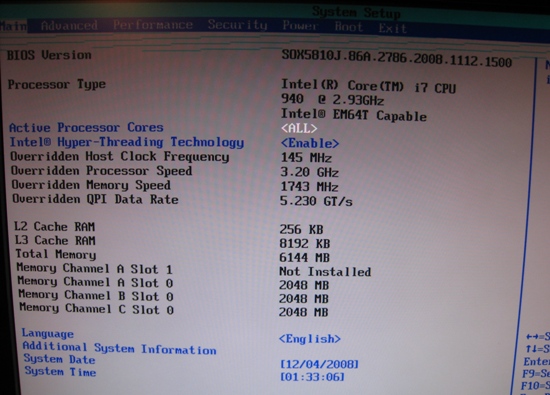
BIOS Config. 2
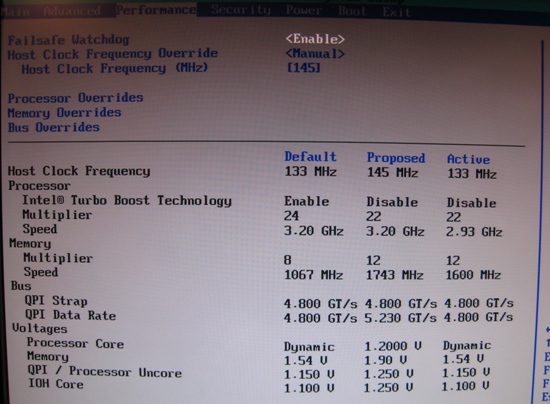
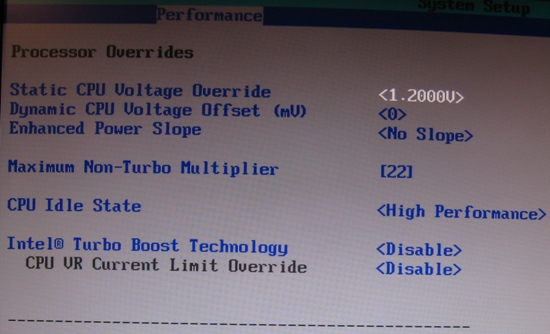
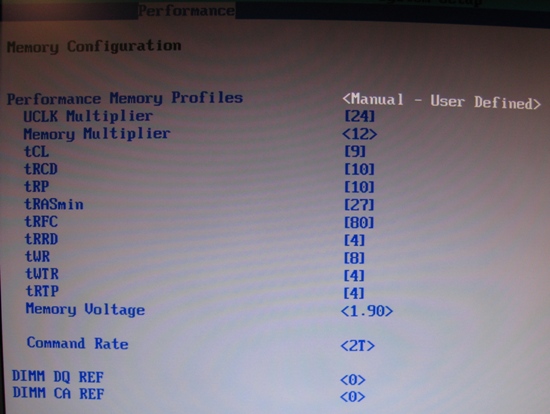
Memory Config. 1
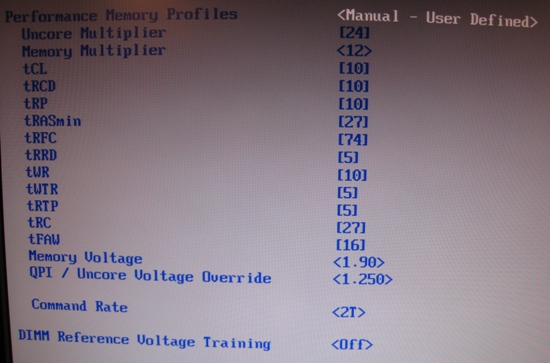
Memory Config. 2
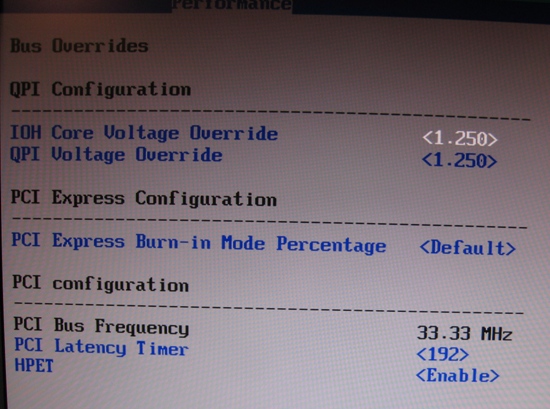
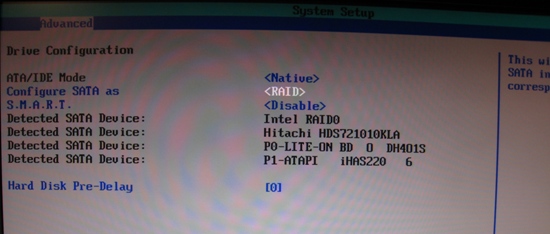
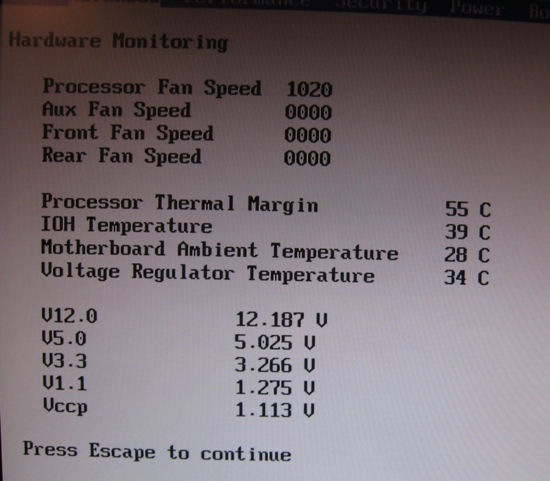
Gary has been working with X58 motherboards for some time now, and an overclocking guide is coming up in the future. This was my first experience with Core i7 and there are some differences compared to Core 2 platforms, but most of the necessary settings are present here in the BIOS. The "uncore" multiplier, typically twice that of the memory, allows for adjustment of the QPI link when the base clock is increased. There are two shots of the main BIOS screen and the Memory settings due to the two systems we received; again, more on that in a moment.
First boot is clean, with low overhead.
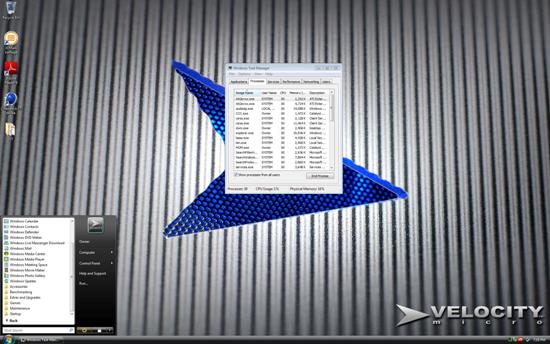 |
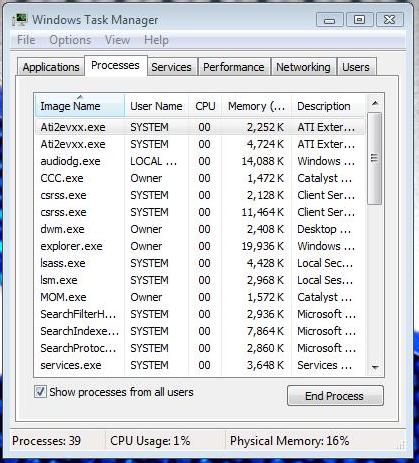
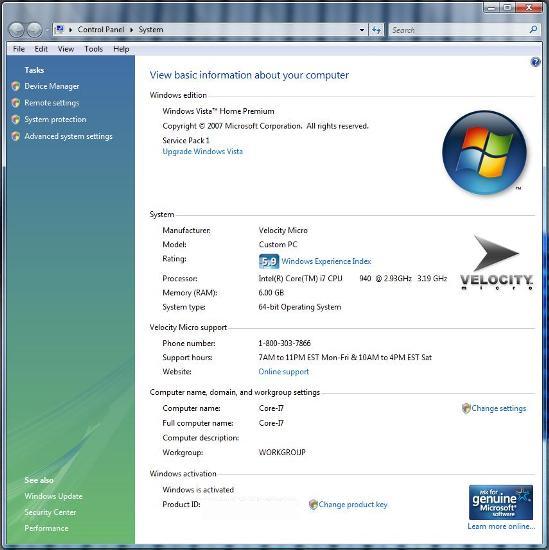
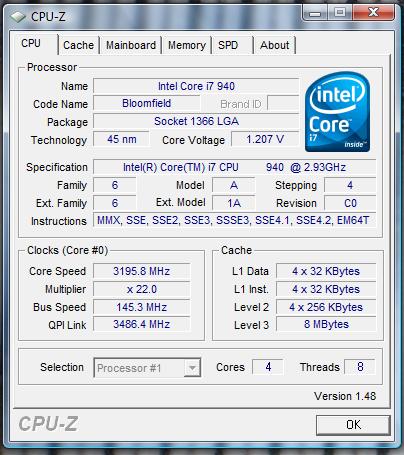
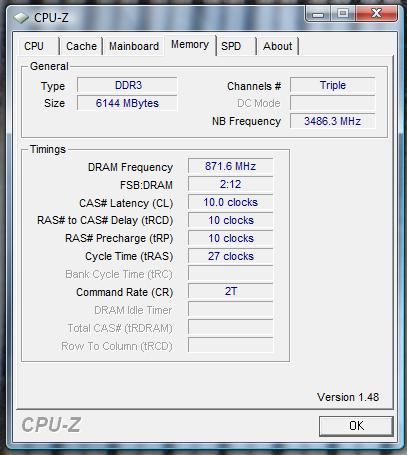

There are no extraneous programs or bloatware on the system, as Velocity Micro promises. The number of processes is reasonably low for Vista, and a basic edition of 3DMark Vantage comes installed only if desired. Their support information is prominently displayed in System Information, which is great. We don't like to see a lack of an anti-virus system though, even if it's an optional install on startup, or similar to 3DMark is selected (or not) when being ordered.
We don't normally delve into the Vista settings or usability very much, but in this case there were a number of small tweaks that bear mentioning. First of all, automatic updates, user account control, and system restore were all set to Off. To our minds this is a plus, as these are all settings an enthusiast would normally disable anyway. TCP/IP settings arrived set to "Manual" with a local DNS server and static IP - clearly this is a mistake, and it was present on both of our test systems, but we suspect it wouldn't happen to a typical end user and we'll write it off as a review sample anomaly.
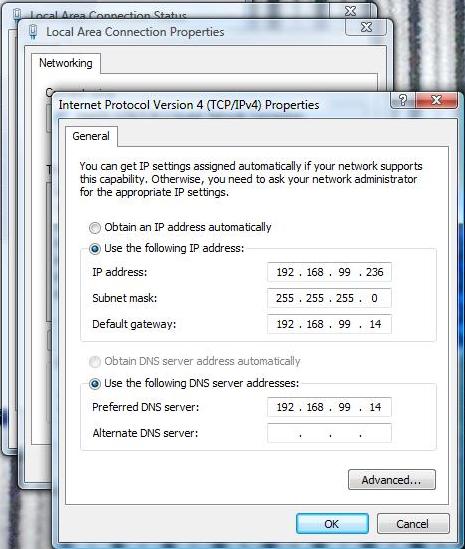
Recent programs were also disabled, which we found slightly annoying - many users do make use of that function in Vista (especially reviewers who take lots of screenshots), so we re-enabled that feature. The program TweakVI came installed with a number of plug-ins.

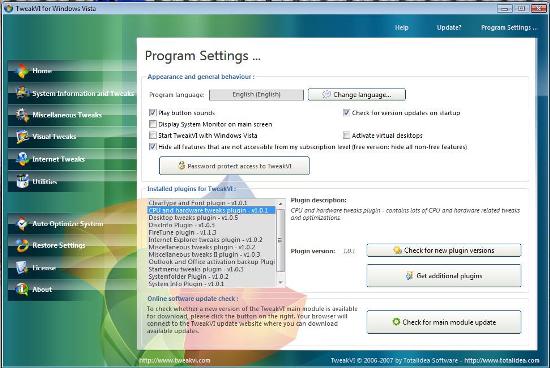
It provides a number of ways to tweak Vista to one's liking, so we count it as a plus and not bloatware. The case itself doesn't have a front USB port, which is slightly annoying from a usability standpoint, and the Recycle Bin was set to permanently delete everything, which may be alright for some but is certainly worth flagging as a potential negative. Hopefully that was another anomaly in the review system; some of us use that setting, but that's one that should be left up to the end user and not made on the factory floor.
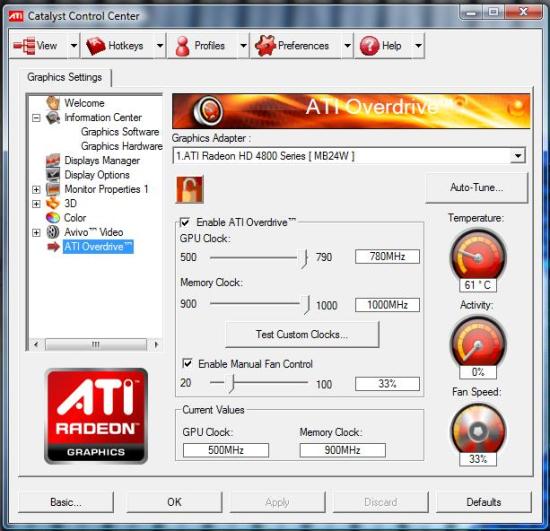
The video card drivers were up-to-date at the time of shipping (8.11), and we also installed the recent hotfix for Far Cry 2. Later, we installed the Beta of 8.12, and have documented those results. Overdrive was also enabled, but we tested at default settings.
General Performance
CINEBENCH R10
CINEBENCH places a heavy load on the CPU during the rendering tests, and can utilize a single CPU or multiple cores. The video subsystem has no bearing on the CPU rendering portion of this benchmark.
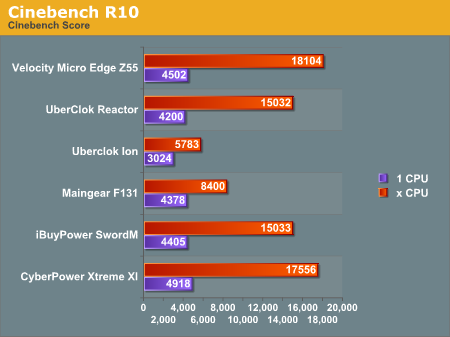
Even at a 3.2GHz clock speed, compared to the 4.0GHz quad-cores shown in the graph, the Edge Z55 and its Core i7 not only hold their own but a set a new high for multi-core performance. The Core i7 architecture really shines in this application, and Hyper Threading provides a minor boost as well allowing the multi-core increase to hit 4.02x.
PCMark Vantage
Our new standard for general platform performance, the PCMark Vantage suite provides a wide series of tests, some of which focus on the CPU while others also utilize the video subsystem, and include digital photo manipulation, webpage loading, video transcoding, High Definition content playback, and so forth.
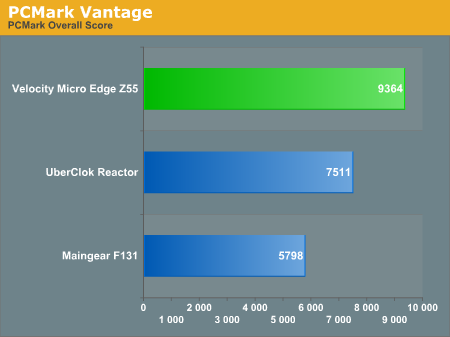
The Edge Z55 enjoys a healthy lead here over our previous (single GPU) test systems.
Gaming/3D Performance
3DMark Vantage
As we mentioned in previous reviews, Vantage is a new addition to our test suite to replace the aging 3DMark 2006, and though the new payment scheme is inconvenient, it is still user reproducible (once). Vantage runs on Windows Vista only, and has four different default test settings: Entry, Performance, High, and Xtreme.
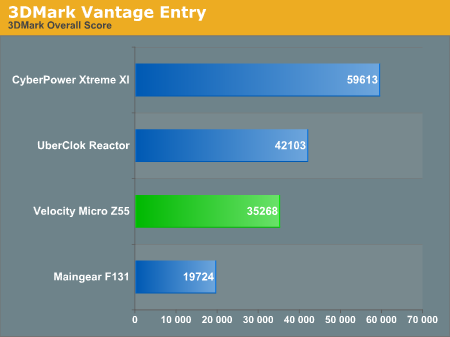
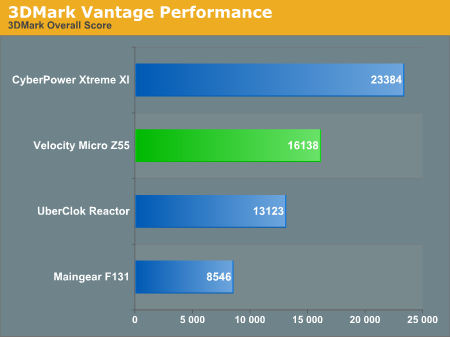
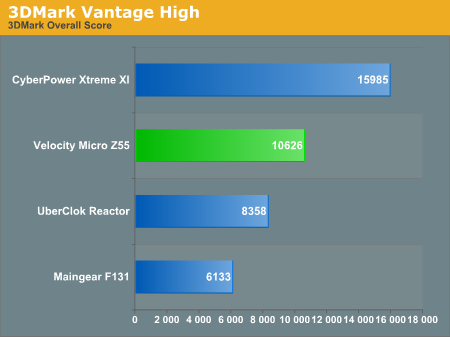
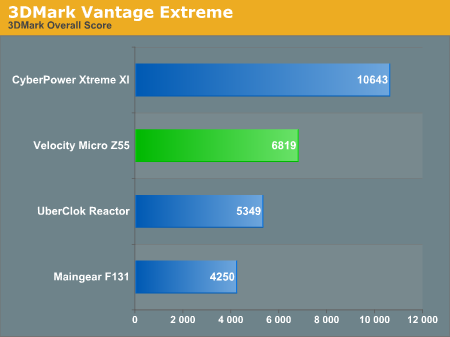
The Reactor is a Core 2 Quad machine at 3.4GHz with a GTX 280, while the CyberPower is a 4.0GHz Core 2 Quad with two GTX 280 cards in SLI. In the Entry run, which is primarily dependent on the CPU, the Edge Z55 is held back by its clock speed. At Performance and higher, once GPU power begins to factor in, the Z55 takes its rightful place ahead of the Reactor and F131, but still trails the Xtreme XI system.
Crysis
Crysis is punishing to even the most recent PC hardware. This demo also has two built-in benchmarks in the "bin32" folder, one "CPU" and the other "GPU". We ran several configurations to show the scalability of this game. We ran all benchmarks three times, discarding the first result and averaging the other two. We ran all tests at "High" quality unless otherwise specified. These results used the 8.12 beta drivers.
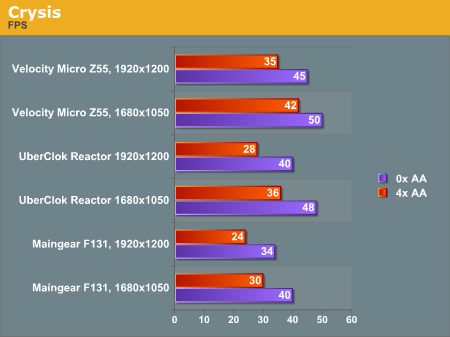
Always ready for more GPU power, Crysis performs very well on the Z55.
Far Cry 2
Far Cry 2 is a new addition to our test suite. It's a fun game with great ratings, and has a fantastic built in benchmarking tool (located in the "bin" folder with the executable, or right-click on the shortcut in Games and select "Benchmark"). We've chosen to run our system tests with the reproducible settings shown below:
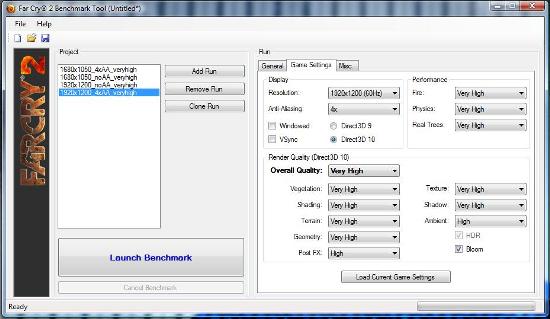 |
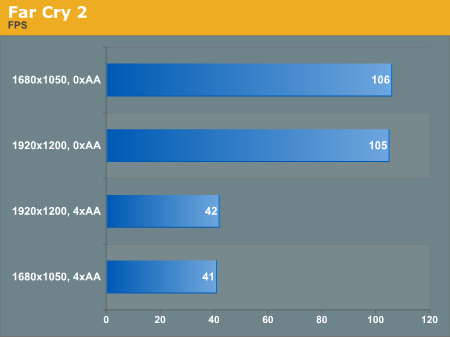
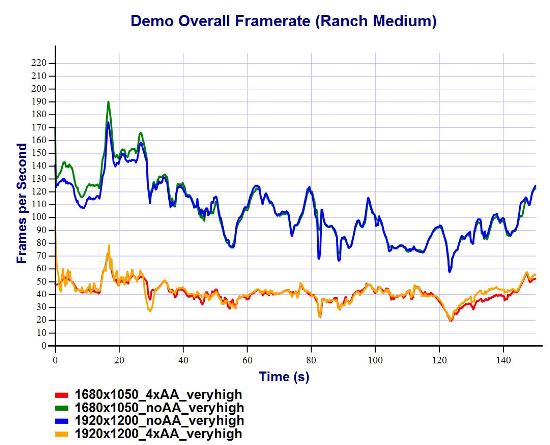
As this is our first system through the tests, we don't have direct comparisons yet, but the game looked fantastic. Here we see a clear delineation between CPU constraint without anti-aliasing, and GPU constraint with 4xAA. 1920x1200 at 2xAA is a great playable framerate on this system at Very High quality.
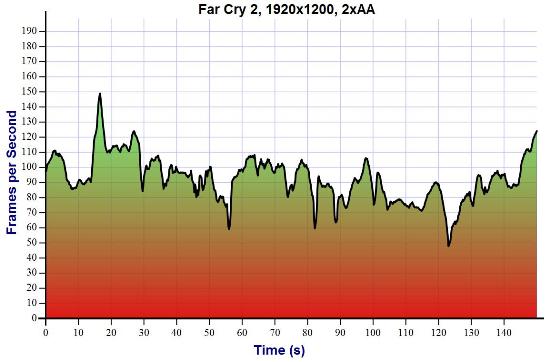
Power
We measure power consumption using a Kill-A-Watt device at the wall outlet. Idle indicates a measurement taken in Windows with no applications running. Max indicates the maximum power draw with the system fully loaded (running eight instances of Prime95 and 3DMark Vantage simultaneously). We've also indicated power draw with just the CPU loaded.
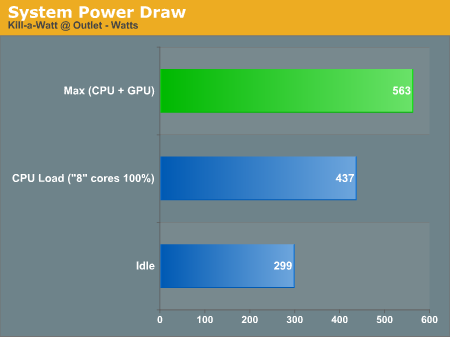
Noise
We measured noise with a sound level meter, at distances of 24" and 48". The chipset fan dominated the noise produced. For reference, ambient noise was approximately 37.5 dB(A).
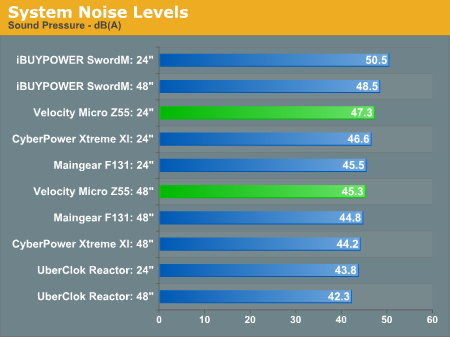
These are the maximum noise levels under a full CPU load. At idle, the system was 1.2 - 1.4 dB(A) less than the values shown. Subjectively, the system is fairly quiet apart from the chipset fan, which is high-pitched enough to be annoying over long periods.
Temperature
We utilized CoreTemp 0.99.3 to measure CPU temperatures, which has incorporated the latest TjMax values for Intel processors. We loaded each core with Prime95 and ran 3DMark Vantage in the background.
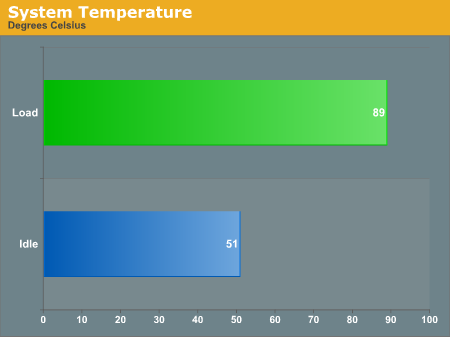
The Core i7 processor is notorious for running quite hot. Compounding this, we have an overclocked gaming system that is using a stock Intel heatsink and fan, which is unusual. Temperatures climbed above 80°C in about a minute, and settled out near the 90°C mark. At only 3.2GHz, clearly this is a limiting factor, as we remarked in the opening.
Problems
We don't always have much of substance to put in our "Problems" section, but being one of the earliest launch systems of Core i7, we had our fair share of trouble with the Z55.
When our system first arrived a few days before the November 17 launch date, we eagerly delved into testing. As with romance, at first everything seemed wonderful; then problems started to appear. Though stable enough to complete a 3DMark run, Prime95 would crash the system in less than an hour (sometimes within 5 minutes). Though high, temperatures were within the range of operation, and regardless thermal throttling should kick in for CPU heat issues. We tried a number of small tweaks and spent some time on the phone with Mario at Velocity Micro, the builder for our system. Ours was the only review system reporting problems, and after stepping through some other ideas, they decided the most expedient solution to save us troubleshooting time was to get us another system. In speaking with Mario, we were impressed with his knowledge and VM's test methodology.
While waiting, we decided to wipe VM's BIOS settings and start from scratch. After hours of testing, we had the system rock-solid at 3.3GHz, but only at low memory speeds (600MHz). The system became very unstable at higher rates. While building us the new system, Mario informed us he saw an identical problem with a certain batch of RAM. However, the new system that we received had identical batch numbers to that of our "old" system.

Once we received our new system (which by this time was shipping to hundreds of customers), we expected our problems to largely disappear. However, as soon as we booted up we had a new set of issues. This is the screen we were greeted with:
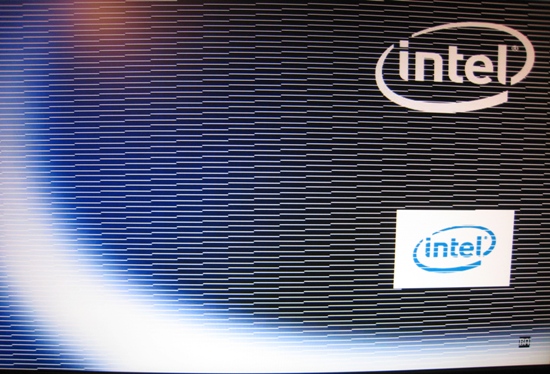
Or more like this, later on in the boot cycle:
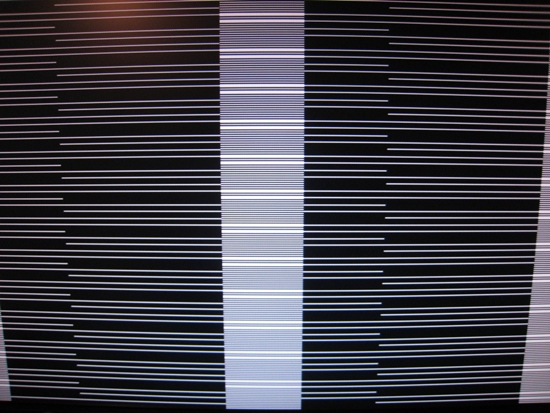
Great. Diving back into troubleshooting, the first thing we tried (after removing one of the 4870s) was altering the PCIe Latency Timer setting in the (updated) BIOS, which Mario had previously told us is very problematic with ATI cards and specifically CrossFire setups. A setting of 192 stabilized the system, but we were still getting a little screen corruption and crashing in CrossFire mode. Scavenging and swapping in the two cards from our previous system seemed to solve our problems, and system testing was started. Midway through our benchmarking, however, we noticed some performance issues, and that CrossFire was no longer showing up in the Catalyst Center. A quick look in Device Manager showed one of our cards with a yellow exclamation point - it was disabled due to a "Code 43" error. Our CrossFire setup was only using one 4870!
Forcing the video card back on, reinstalling the ACPI driver (a suggestion found in several forums on the Code 43 topic with ATI cards), a few reboots, and a 10" desk fan pointing into the chassis to alleviate any heat problems stabilized the system enough to collect some results on the 8.11 drivers.

However, with the host of problems we'd run into, and being a new chipset platform, we also wanted to try the latest and greatest drivers, and installed the 8.12 beta from ATI. In general, they made the system a little more predictable but it still exhibited some problems, particularly in 3DMark where we saw some graphics corruption.
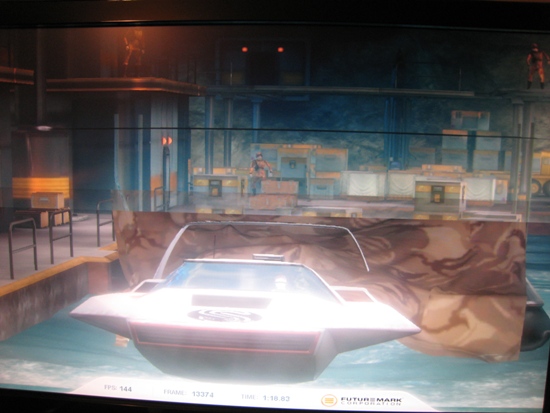
Overall, it seemed like the system had a lot of potential, but couldn't follow through when it came to stability. Whether this was caused by the early nature of the hardware (very likely), inadequate CPU cooling (also likely), or something else, the fact remains that anyone buying a new high-end system would be very unhappy if it failed to run properly. Then again, it's called the bleeding edge for good reason.
Overclocking
One big upside to the problems we encountered is that we spent a long time tinkering in the BIOS and, therefore, we spent quite a while testing the limits of the system. Particularly since it was my first experience with Core i7, I wanted to see how far the Edge Z55 would go.
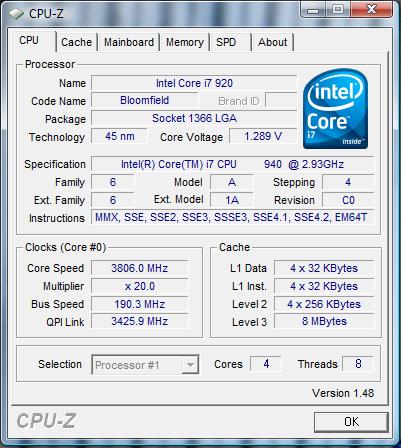
We easily hit 3.8GHz with the Core i7-940, at a BCLK of 190MHz. The huge limiting factor was not the motherboard or CPU but the Intel heatsink, as temperatures would quickly shoot to 100°C (the thermal throttling point) under load.
Keeping QPI close to stock is important for stability; anything above around 6.8 GT/s (or 3400MHz in CPU-Z) and stability was compromised. We did boot and idle at desktop at almost 7.9 GT/s, but any load situation would crash.
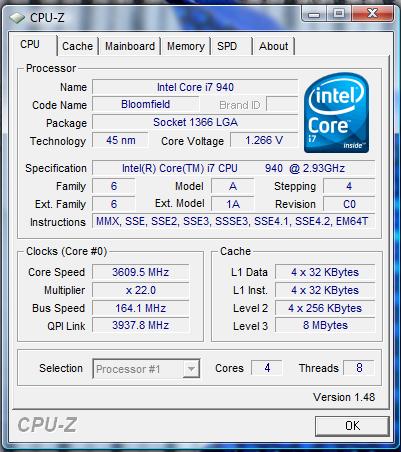
Heat prevented us from doing much testing at 3.8GHz, but we did run through the CINEBENCH CPU tests.
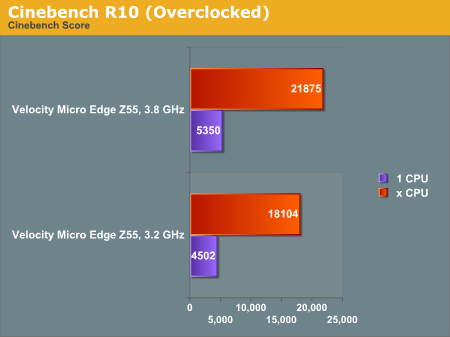
Pricing and Warranty
As configured, the Edge Z55 retails for around $3600. The Core i7-940 alone retails for around $570 right now, and the Intel motherboard around $260 - already we're over the $800 mark. Accounting for a quality aluminum case from Silverstone, drives, fans, etc., the cost rolls up to around $2400. This is a quite a large premium, even accounting for items like the "free" games, but a 40% margin is fairly typical for high-end system manufacturers and they are close to this mark. It does include some intangibles for the customer, like the customization steps Velocity Micro takes in the case to make their product stand apart, and the time spent in testing and customizing the operating system.
When it comes to product warranty support, Velocity Micro has an advantage here as their technical support personnel are the actual system builders. Any problem with a system is referred back to the person who constructed and tested it, by hand, in the Virginia office. This is impressive for a company of their size. 24/7 Technical Support is not standard but available as an upgrade, and provides an on-call technician for "emergency" problems only such as no-boot situations. Though we had our share of problems with our system, the people we talked to were very knowledgeable, burned each system in with custom scripts of blended small/large runs in Prime95 and had a good understanding of BIOS tweaks. One gripe that we have is that the standard warranty offered is a 1-year depot service only. On higher end gaming systems such as this, the level of investment is deserving of a 3-year warranty. This is an available option and costs an additional $169 including on-site support, but we hope this is a point that Velocity Micro tries to convey as an important choice to the more uninformed buyers.
Final Thoughts
It's difficult to summarize our experiences with the Edge Z55. We were certainly plagued with a number of issues, but our impression coming away is that this is the result of the early adoption of the X58 platform and Core i7, and the growing pains that come with it. In terms of fit and finish, Velocity Micro does a great job of differentiating their product from the pack with visual appeal, clean assembly, and the largest number of BIOS, program, and operating system tweaks that we've ever seen in a PC supplier. In the line item of "performance tuning", Velocity Micro promises small and delivers big. Every component choice was top quality, and their support high caliber. They do, in fact, still have what it takes to compete with the boutiques. It's difficult to put a gut feeling into words, but this felt like it was a solid offering that just kept missing the mark.
On the other hand, if we put ourselves in the seat of a consumer who had purchased this system, we would be sorely disappointed. The problems that we encountered were frustrating enough just in benchmarking; if this was an anticipated gaming machine for home use, the user would most assuredly have become disgusted regardless of the steps taken to correct it. There are also some areas we feel they fall short, such as not offering guaranteed overclocks (like their associated Overdrive PC branch) and retaining a standard Intel heatsink and fan, often as their sole offering.
When it comes to systems, different users are looking for different things. In the arena of top-notch gaming machines that set themselves apart from the crowd (and those willing to pay for it), we would have awarded Velocity Micro an Editor's Choice award if the system had followed through. As it is, we can't do that today, but came away with a good impression of Velocity Micro despite the bad taste in our mouth from the problems we had. We'd still recommend keeping them on your short list of high-end suppliers, and welcome them to submit another (more mature) product for consideration in the future. Being first out the gate with new hardware is great… but only if the hardware actually works as advertised.







